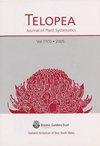转移三种凯拉提亚。卡索尼斯·拉夫。(葡萄科)。
IF 0.5
4区 生物学
Q4 PLANT SCIENCES
引用次数: 2
摘要
系统发育研究表明,朱斯鳄不是单系的。Cayratia s.str。现在仅限于那些具有u形胚乳而不是t形胚乳的物种。后者现在分为三属。,文俊,吕立明,陈志东,及一非洲属。因此,出现在澳大利亚的三种植物需要新的组合:Causonis clematidea (F. Muell)。杰克,C. eurynema (B.L.Burtt)杰克和C. maritima(杰克)杰克。日本香菜(拇指属)Gagnep。和三叶树(Cayratia trifolia)。域,已转移到Causonis,作为Causonis japonica (Thunb)。英国皇家空军。和三叶草(L.)Mabb。& J.文。本文章由计算机程序翻译,如有差异,请以英文原文为准。
Transfer of three species of Cayratia Juss., to Causonis Raf. (Vitaceae).
Phylogenetic studies have shown that Cayratia Juss is not monophyletic. Cayratia s.str. is now confined to those species with a U-shaped endosperm rather than a T-shaped endosperm. The latter are now in three genera Causonis Raf., Pseudocayratia J. Wen, L.M. Lu & Z.D. Chen, together with an undescribed African genus. As a result, new combinations are required for three species occurring in Australia: Causonis clematidea (F. Muell.) Jackes, C. eurynema (B.L.Burtt) Jackes and C. maritima (Jackes) Jackes. Cayratia japonica (Thunb.) Gagnep., and Cayratia trifolia (L.) Domin, have been transferred to Causonis, as Causonis japonica (Thunb.) Raf., and Causonis trifolia (L.) Mabb. & J. Wen.
求助全文
通过发布文献求助,成功后即可免费获取论文全文。
去求助
来源期刊

Telopea
PLANT SCIENCES-
CiteScore
1.30
自引率
42.90%
发文量
0
期刊介绍:
Manuscripts submitted for publication in TELOPEA are published online, after peer review and acceptance by the TELOPEA Editorial Committee and when final editorial formatting has been completed. The journal specialises in plant systematics and phylogeny. The geographic scope of the journal encompasses Australia, Malesia, Melanesia, Micronesia, and Polynesia. The suitability of a work for the journal depends on the topic and the region of origin, generally the narrower the focus of the manuscript the closer to New South Wales must be its geographic focus.
As a general guide, we will consider:
1) revisionary treatments and other substantial bodies of work from any of the regions mentioned above.
2) new species from any Australian state.
3) new country records for Australia from any state.
4) new state records from New South Wales only.
However, we aim to support botanical research across the broader Australasian and Pacific region, and will consider submissions on their merit.
Generally we will not consider extraterritorial new country records, or single lectotypification papers unless they pertain to New South Wales taxa, or have significant bearing on the Australian flora.
 求助内容:
求助内容: 应助结果提醒方式:
应助结果提醒方式:


